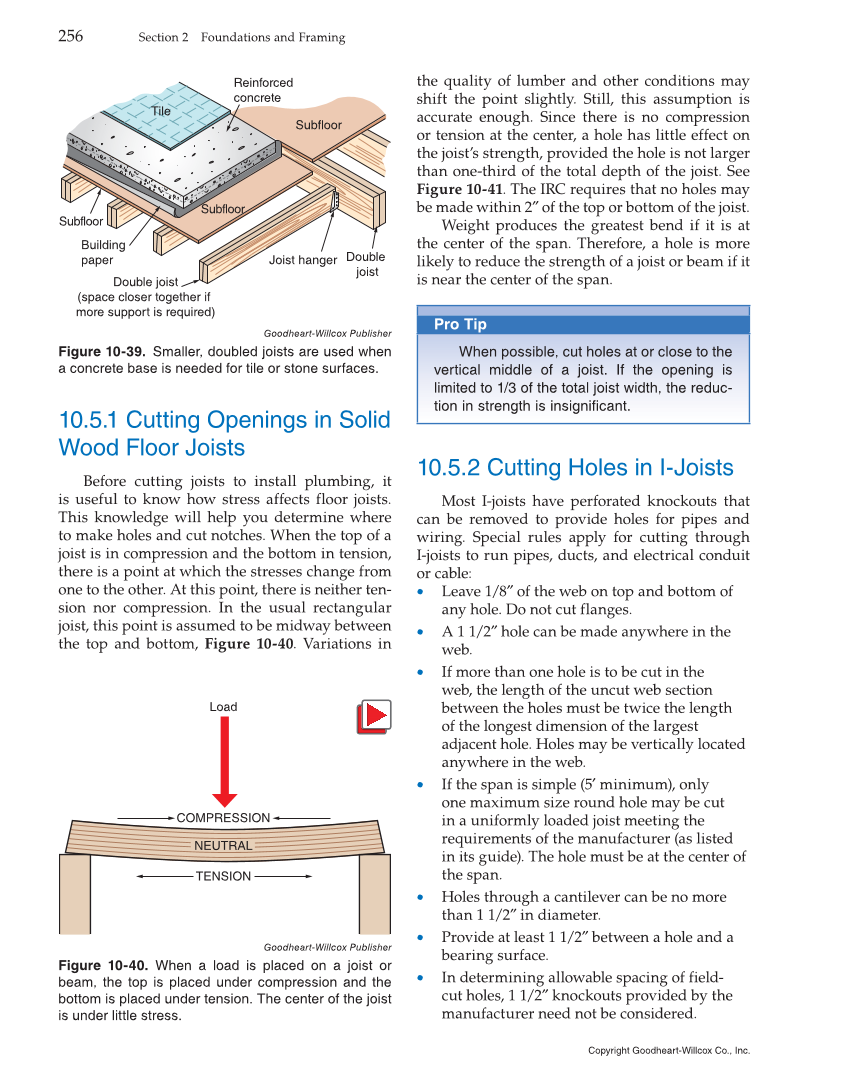256 Section 2 Foundations and Framing 10.5.1 Cutting Openings in Solid Wood Floor Joists Before cutting joists to install plumbing, it is useful to know how stress affects floor joists. This knowledge will help you determine where to make holes and cut notches. When the top of a joist is in compression and the bottom in tension, there is a point at which the stresses change from one to the other. At this point, there is neither ten- sion nor compression. In the usual rectangular joist, this point is assumed to be midway between the top and bottom, Figure 10-40. Variations in the quality of lumber and other conditions may shift the point slightly. Still, this assumption is accurate enough. Since there is no compression or tension at the center, a hole has little effect on the joist’s strength, provided the hole is not larger than one-third of the total depth of the joist. See Figure 10-41. The IRC requires that no holes may be made within 2″ of the top or bottom of the joist. Weight produces the greatest bend if it is at the center of the span. Therefore, a hole is more likely to reduce the strength of a joist or beam if it is near the center of the span. Pro Tip When possible, cut holes at or close to the vertical middle of a joist. If the opening is limited to 1/3 of the total joist width, the reduc- tion in strength is insignificant. 10.5.2 Cutting Holes in I-Joists Most I-joists have perforated knockouts that can be removed to provide holes for pipes and wiring. Special rules apply for cutting through I-joists to run pipes, ducts, and electrical conduit or cable: • Leave 1/8″ of the web on top and bottom of any hole. Do not cut flanges. • A 1 1/2″ hole can be made anywhere in the web. • If more than one hole is to be cut in the web, the length of the uncut web section between the holes must be twice the length of the longest dimension of the largest adjacent hole. Holes may be vertically located anywhere in the web. • If the span is simple (5′ minimum), only one maximum size round hole may be cut in a uniformly loaded joist meeting the requirements of the manufacturer (as listed in its guide). The hole must be at the center of the span. • Holes through a cantilever can be no more than 1 1/2″ in diameter. • Provide at least 1 1/2″ between a hole and a bearing surface. • In determining allowable spacing of field- cut holes, 1 1/2″ knockouts provided by the manufacturer need not be considered. Subfloor Subfloor Reinforced concrete Double joist (space closer together if more support is required) Double joist Joist hanger Subfloor Building paper Tile Goodheart-Willcox Publisher Figure 10-39. Smaller, doubled joists are used when a concrete base is needed for tile or stone surfaces. TENSION NEUTRAL Load COMPRESSION Goodheart-Willcox Publisher Figure 10-40. When a load is placed on a joist or beam, the top is placed under compression and the bottom is placed under tension. The center of the joist is under little stress. Copyright Goodheart-Willcox Co., Inc.
